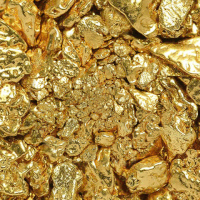Minerals and Ores
↪ Mineral is the naturally occurring substance that has a characteristic chemical composition and in general a crystalline structure.
↪ Rocks are composed of mixture of minerals.
↪ Many names of minerals end in -ite.
↪ A mineral is naturally occurring matter from which a metal may or may not be extracted profitably and minerals from which metals can be extracted profitably and economically are called ores.
↪ Thus every ore is mineral but every mineral is not an ore.
↪ For example, clay (Al2O3.2SiO2.2H2O) is a mineral of aluminum but not its ore.
↪ On the other hand bauxite (Al2O3.2H2O) is an ore of aluminum.
↪ Ores are found in nature mostly in combined state.
↪ Noble metals such as Au, Pt, W, Ag etc. to some extent, are found in nature in free uncombined state in association with earthy impurities, such state is called native state.
↪ Therefore ores are classified as combined state ore and native ore.
↪ If an ore contains only one metal it is called simple ore and if it contains more than one metal is called complex ore.
↪ Ores in combined state remain in the form of chemical compounds in association with earthy impurities.
↪ This type of ore, on the basis of nature of compounds is classified in three major groups as follows:
⁕ Oxidized or oxo ores
↪ In this type of ore, metals remain in nature in oxidized state by combining with oxygen as oxides and by long time weathering form compound oxides as carbonates, nitrates, sulphates, phosphates etc.
↪ Some examples of this type of ore of metal are given with formulae and commercial names as:
⇲ Cu2O (Cuprite),
⇲ Fe2O3 (Haematite),
⇲ Fe3O4 (Magnetite),
⇲ MnO2 (Pyrolusite),
⇲ SnO2 (Tin stone or cassiterite),
⇲ Al2O3.2H2O (Bauxite),
⇲ CaCO3 (Marble),
⇲ CaCO3MgCO3 (Dolomite),
⇲ ZnCO3(Calamine),
⇲ MgCO3(Magnesite),
⇲ CaSO4.2H2O (Gypsum),
⇲ NaNO3 (Chille salt petre),
⇲ Ca3(PO)2 (Phospherite),
⇲ CuCO3Cu(OH)2 (Malachite) etc.
⁕ Sulphurated ores
↪ These ores are found as sulphides (simple ore) and pyrites (Fool's gold).
For example:
⇲ Cu2S(Copper glance),
⇲ PbS(Galena),
⇲ ZnS (Zinc blende or sphalerite),
⇲ HgS(Cinnabar),
⇲ Ag2S(Silver glance),
⇲ FeS2 (Iron pyrites),
⇲ CuFeS2 (Copper pirates or chalcopyrites) etc.
⁕ Halide ores
↪ Ores found in nature by combining with halogens are called halide ores.
For examples:
⇲ NaCl (Rock salt)
⇲ AgCl (Horn silver)
⇲ CaF2 (Flurospar)
⇲ KCl.MgCl2.6H2O (Carnallite)
⇲ AlF3.3NaF (Cryolite), etc.
Gangue or Matrix
↪ Ore contains a large amount of rocky minerals as silicates, sand, mica, carbonates etc. as impurities.
↪ And these impurities are called as gangue or matrix.
↪ Gangue or matrix is waste matter which is to be removed to get metal from ores.
↪ For examples:
In extraction of copper from pyrites ore, the gangue i.e., impurities are iron oxide CaCO3, etc.
Different Metals and Their Ores Found in Nepal
| Name of metal | Minerals | Places |
| Iron | Haematite (Fe2O3)
Magnetite (Fe2O4)
Limonite (2Fe2O3.3H2O) | Bajhang, Those (Ramechap),
Pyuthan, Phulchoki,
Bandipur, Chitwan |
| Calcium | Limestone (CaCO3) | Jogimara, Chobhar, Surkhet |
| Magnesium | Magnesite (MgCO3)
Talc
Dolomite (CaCO3.MgCO3) | Kharidhunga, Udaypur |
| Copper | Chalcopyrite (CuFeS2)
Copper bornite (Cu.5FeSO4) | Chisapani, gadhi, Galkot |
| Gold | Alluvial gold
Natural gold
Native gold | Gandaki and karnali rivers,
Sunkhoshi, Rapti river |
| Zinc/lead | Galena (PbS)
Zinc blende (ZnS)
Colamine (ZnCO3) | Galkot
Phulchoki
Ganesh himal |
| Cobalt | Cobaltite ( CoAs3S2) | Palpa, Gulmi |
| Bismuth | Bismuth ore | Bhimphedi |
| Nickel | Nickel ore | Taplejung |
| Uranium | Free state | Bhangale (Makwanpur) |
Differences between Minerals and Ores
| Minerals | Ores |
All the naturally occurring substances that are present in the earth’s crust are known as Minerals.
| Ores are usually used to extract metals economically. A large number of metals are present.
|
All Minerals are not ores.
| All ores are minerals.
|
Minerals are native forms in which metals exist.
| Ores are mineral deposits.
|








